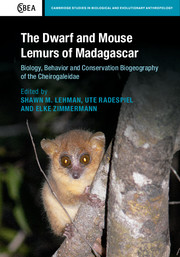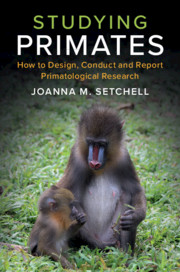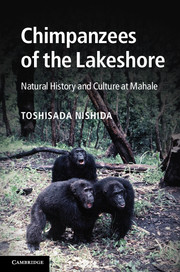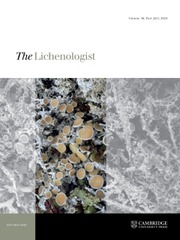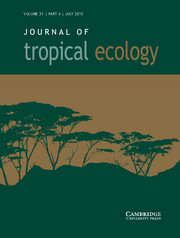The Dwarf and Mouse Lemurs of Madagascar
Biology, Behavior and Conservation Biogeography of the Cheirogaleidae
$137.00 (C)
Part of Cambridge Studies in Biological and Evolutionary Anthropology
- Editors:
- Shawn M. Lehman, University of Toronto
- Ute Radespiel, University of Veterinary Medicine Hannover, Foundation
- Elke Zimmermann, University of Veterinary Medicine Hannover, Foundation
- Date Published: May 2016
- availability: Available
- format: Hardback
- isbn: 9781107075597
$
137.00
(C)
Hardback
Other available formats:
Paperback, eBook
Looking for an examination copy?
If you are interested in the title for your course we can consider offering an examination copy. To register your interest please contact [email protected] providing details of the course you are teaching.
-
The dwarf and mouse lemurs of Madagascar are two very species-rich lemur genera, yet there is a relative paucity of information on this primate family in published literature. In this first ever treatment of the Cheirogaleidae, international experts are brought together to review and integrate our current knowledge of the behaviour, physiology, ecology, genetics and biogeography of these species. A wide range of direct and indirect research methods that are currently used to study these cryptic nocturnal solitary foragers are described. By uniting often disparate research on captive and free-ranging taxa and synthesising recent methodological advances, this book provides new insights that will encourage further studies of this fascinating primate family. This synthesis will provide an incentive for more integrative studies of the Cheirogaleidae in captivity and in the wild, enabling the impacts of deforestation and other factors to be identified and directions for future conservation efforts to be established.
Read more- The first ever complete work on the Cheirogaleidae family which will encourage further research on the behaviour, ecology and conservation of dwarf and mouse lemurs
- Presents a wide range of methodological approaches for the study of these species, which is appropriate introductory reading for students interested in lemurs
- Serves as a complete summary of existing research on the cheirogaleids, assessing their current species status and making a compelling case for their future conservation
Reviews & endorsements
'… a very useful overview for anyone interested in nocturnal primates and in Madagascan biogeography. Many of the chapters provide excellent syntheses and cover conflicting theories, backed by a ready-made reading list on the subject, which contextualise the datasets presented to help address particular questions. There is no doubt our knowledge of these cryptic little lemurs will continue to expand substantially in the future, building on many of the diverse studies presented in this book.' Anna T. C. Feistner, Primate Eye
Customer reviews
Not yet reviewed
Be the first to review
Review was not posted due to profanity
×Product details
- Date Published: May 2016
- format: Hardback
- isbn: 9781107075597
- length: 570 pages
- dimensions: 253 x 178 x 30 mm
- weight: 1.31kg
- contains: 88 b/w illus. 29 colour illus.
- availability: Available
Table of Contents
List of contributors
Foreword
Part I. Cheirogaleidae: Evolution, Taxonomy, and Genetics:
1. Cheirogaleid diversity and evolution: big questions about small primates
2. The taxonomy of Cheirogaleidae: an ever expanding species list
3. Mitogenomics of the family Cheirogaleidae and relationships to taxonomy and biogeography
4. Why cheirogaleids are bad models of primate ancestors: a phylogenetic reconstruction
5. Contact zones and species sympatry in dwarf lemurs (Genus Cheirogaleus): the roles of ecological adaptation and sexual selection
Part II. Methods for Studying Captive and Wild Cheirogaleids:
6. How to anesthetize mouse lemurs
7. Microcebus murinus – a unique primate for modeling human brain disorders, including Alzheimer's disease and bovine spongiform encephalopathy
8. Life history variation in mouse lemurs: the effect of environmental and phylogenetic determinants
9. The effects of the lunar cycle, temperature, and rainfall on the trapping success of wild brown mouse lemurs (Microcebus rufus) in Ranomafana National Park, southeastern Madagascar
10. Tiny samples from tiny lemurs: methodological considerations for endoparasite analyses in mouse lemurs
11. A review of ectoparasites in the Cheirogaleidae
Part III. Cheirogaleidae: Behavior and Ecology:
12. Morphology, behaviour, ranging patterns and habitat use of the northern giant mouse lemur (Mirza zaza) in Sahamalaza, northwestern Madagascar
13. Living in riverine and xeric forests: Microcebus griseorufus at Beza Mahafaly, SW Madagascar
14. Determinants of intra- and interspecific isotopic variation in mouse lemurs from northwestern Madagascar
15. Your food, my food: patterns of resource use in two sympatric mouse lemur species
16. The physiology of phyletic dwarfism in Cheirogaleidae
17. Possible causes and consequences of different hibernation patterns in Cheirogaleus species – Mitovy fatsy sahala
18. Seed dispersal by mouse lemurs: Do Microcebus represent a unique frugivorous guild?
Part IV. Cheirogaleidae: Sensory Ecology, Communication, and Cognition:
18. Seed dispersal by mouse lemurs: do Microcebus represent a unique frugivorous guild?
19. Predation in the dark: anti-predator strategies of Cheirogaleidae and other nocturnal primates
20. The gray mouse lemur (Microcebus murinus): a novel cognitive primate brain aging model
21. Acoustic divergence in communication of cheirogaleids with special emphasis to mouse lemurs
22. Modeling the origins of primate sociality: social flexibility and kinship in mouse lemurs (Microcebus spp.)
Part V. Cheirogaleidae: Conservation Biogeography:
23. Ecological niche modeling of mouse lemurs (Microcebus spp.) and its implications for their species diversity and biogeography
24. Edge effects on tree dendrometrics, abiotics, and mouse lemur densities in western dry forests in Madagascar
25. Factors determining Microcebus abundance in a fragmented landscape in Ankarafantsika National Park, Madagascar
26. Can behavioural ecology help to understand the divergent range sizes of mouse lemurs?
27. Conservation biology of the Cheirogaleidae: future research directions
Index.
Sorry, this resource is locked
Please register or sign in to request access. If you are having problems accessing these resources please email [email protected]
Register Sign in» Proceed
You are now leaving the Cambridge University Press website. Your eBook purchase and download will be completed by our partner www.ebooks.com. Please see the permission section of the www.ebooks.com catalogue page for details of the print & copy limits on our eBooks.
Continue ×Are you sure you want to delete your account?
This cannot be undone.
Thank you for your feedback which will help us improve our service.
If you requested a response, we will make sure to get back to you shortly.
×
